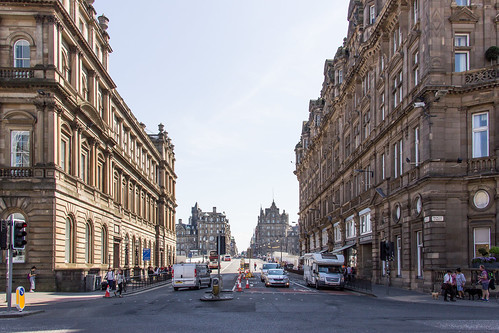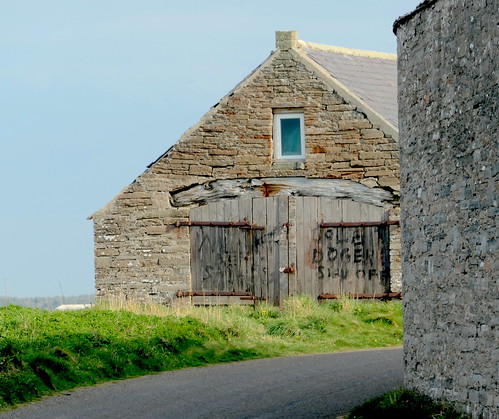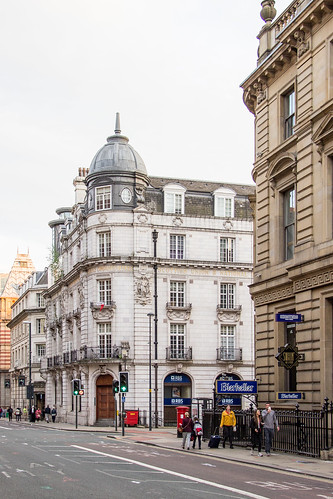North Bridge, New Town, Edinburgh, Scotland

Image by Billy Wilson Photography
View lined with category A listed historic buildings.
"North Bridge is a road bridge and street in Edinburgh linking the High Street with Princes Street, and the Old Town with the New Town. The current bridge was built between 1894 and 1897. A previous North Bridge, built between 1763 and 1772, stood until 1896.
The current North Bridge is 525 feet (160 m) long and has three spans of arched girders each 175 feet (53 m) feet in length. It is 75 feet (23 m) wide. It was constructed from 1894 to 1897 by Sir William Arrol & Co., the company also noted for construction of the Forth Bridge. The design of the ornamentation was by the City architect of the time, Robert Morham.
The foundation stone was laid on 25 May 1896 by the Lord Provost (the Rt. Hon Andrew McDonald, with Masonic ceremonial. A medal was struck commemorating the opening of the bridge on 15 September 1897. The medal shows a view of the bridge with trains underneath and on the obverse a bust of the by then knighted Sir Andrew McDonald.
Situated on the bridge is a war memorial, by sculptor William Birnie Rhind which memorialises soldiers of the King’s Own Scottish Borderers killed in campaigns between 1878 and 1902.
At the southern end of the bridge (where it meets the Royal Mile and South Bridge, in the Old Town) are substantial buildings whose main entrances are at carriageway level but which also have entrances in the valley below. Those on the west side are The Scotsman Hotel, former headquarters of The Scotsman newspaper, alongside a block of commercial premises and flats ("Royal Mile Mansions"). That on the east housed Patrick Thomson’s department store from 1906 until 1976 when its then owner the House of Fraser rebranded it as Arnotts department store. The store closed in 1981 and the building was redeveloped as a hotel and smaller shops.
At the northern end of the bridge, where it meets Princes Street in the New Town, on the west side is the Balmoral Hotel, originally built as the North British Hotel, the North British Railway’s hotel serving Waverley Station, which lies below. On the east side is Waverley Gate, originally the Edinburgh General Post Office, now serving as office space.
The New Town is a central area of Edinburgh, the capital of Scotland. A masterpiece of city planning, it was built in stages between 1767 and around 1850, and retains much of its original neo-classical and Georgian period architecture. Its best known street is Princes Street, facing Edinburgh Castle and the Old Town across the geological depression of the former Nor Loch. Together with the Old Town, the New Town was designated a UNESCO World Heritage Site in 1995.
Edinburgh (/ˈɛdɪnbərə/; Scots: Edinburgh; Scottish Gaelic: Dùn Èideann [ˈt̪uːn ˈeːtʲən̪ˠ]) is the capital of Scotland and one of its 32 council areas. Historically part of the county of Midlothian (interchangeably Edinburghshire before 1921), it is located in Lothian on the Firth of Forth’s southern shore.
Recognised as the capital of Scotland since at least the 15th century, Edinburgh is the seat of the Scottish Government, the Scottish Parliament and the supreme courts of Scotland. The city’s Palace of Holyroodhouse is the official residence of the monarch in Scotland. The city has long been a centre of education, particularly in the fields of medicine, Scots law, literature, philosophy, the sciences and engineering. It is the second largest financial centre in the United Kingdom (after London) and the city’s historical and cultural attractions have made it the United Kingdom’s second most visited tourist destination attracting 4.9 million visits including 2.4 million from overseas in 2018.
Edinburgh is Scotland’s second most populous city and the seventh most populous in the United Kingdom. The official population estimates are 488,050 (2016) for the Locality of Edinburgh (Edinburgh pre 1975 regionalisation plus Currie and Balerno), 518,500 (2018) for the City of Edinburgh, and 1,339,380 (2014) for the city region. Edinburgh lies at the heart of the Edinburgh and South East Scotland city region comprising East Lothian, Edinburgh, Fife, Midlothian, Scottish Borders and West Lothian.
The city is the annual venue of the General Assembly of the Church of Scotland. It is home to national institutions such as the National Museum of Scotland, the National Library of Scotland and the Scottish National Gallery. The University of Edinburgh, founded in 1582 and now one of four in the city, is placed 20th in the QS World University Rankings for 2020. The city is also known for the Edinburgh International Festival and the Fringe, the latter being the world’s largest annual international arts festival. Historic sites in Edinburgh include Edinburgh Castle, the Palace of Holyroodhouse, the churches of St. Giles, Greyfriars and the Canongate, and the extensive Georgian New Town built in the 18th/19th centuries. Edinburgh’s Old Town and New Town together are listed as a UNESCO World Heritage site, which has been managed by Edinburgh World Heritage since 1999." – info from Wikipedia.
Summer 2019 I did a solo cycling tour across Europe through 12 countries over the course of 3 months. I began my adventure in Edinburgh, Scotland and finished in Florence, Italy cycling 8,816 km. During my trip I took 47,000 photos.
Now on Instagram.
Become a patron to my photography on Patreon.








